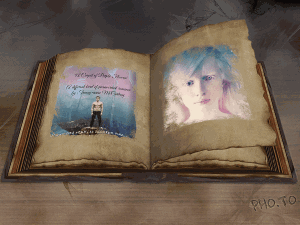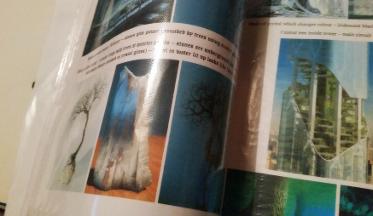INCLUDED CONTENTS
Make an index-styled sheet with the following sections labelled:
CHARACTERS
Primary
Secondary
WORLD
Setting
Rules
Religion
Special Powers
Weapons
Transportation
CLOTHING/ACCESSORIES
RESEARCH
GLOSSARY
Fill out basic information for each section, usually a line or two or a list of names, items, etc. This makes for easy finding later, especially if an item or character is cross-referenced between sections.
CHARACTERS:
Start with a list of characters typed on a single page divided into main characters and secondary characters.
Give each character his/her own page detailing physical traits, internal/eternal conflicts, secrets, goals, family background – basically anything and everything important to that particular character.
Main characters (name, nickname, love interest, height, hair/eye colour, body type, personality basics, job, quirks, food (faves, hates, allergies...), vehicle, important stuff).
Minor characters (books they show up in, job, connection to main characters, significant other, physical description, personality basics, important stuff).
Just include what you’ve mentioned in the book. That means you won’t have eye colour for some characters, or you might have hair length but no colour. You might have no physical description at all.
Every time a character reveals a bit of him or herself to you while you write, click over on your series bible.
WORLD:
Whether you’re writing a contemporary, historical or paranormal novel, you need to create a world. All this info goes in its own section labelled ‘WORLD’.
Here you should include a page for SETTING – time of year, place, type of house or office, etc.
A page or section for RULES/CUSTOMS – rules, customs, laws of your world (this is especially important for historical and paranormal). You can also include special stipulations here, like terms of a will, inheritance, etc.
Locations (building name, type of business, owners, moose (you'll have to read the series to find out about that one!), location in town, exterior description, interior description). Recurring Places.
RELIGION/SPECIAL POWERS/WEAPONS/TRANSPORTATION – each of these categories get their own section in my book bible within the WORLD section. This usually applies to my paranormal works, but if you’re writing historical novels, you can also include a section on Weapons, Carriages/Horses/Transportation, etc. and include any images and research info you might need to check facts later on. You should also list any characters that these specifics pertain to.
“Rules” in your fantasy or futuristic world, etc. You can colour code it so you know when each power, rule, or whatever was introduced.
CLOTHING/ACCESSORIES – Include fabrics and styles of times you set my books, fashions of paranormal worlds, including any special jewellery/items that have magical powers. For contemporary novels a list of trends can be included here or items that are specific to your characters – example: I have one character who loves his Trilby Hat (Book Two)
You can also use this section (ACCESSORIES) if you have an item that cross-references with a special power or an historical object necessary to your book such as a stolen necklace, a magical container, etc. If you do it this way, make a note where the item cross references with another section such as SPECIAL POWERS/WEAPONS, etc. and vice versa.
Quick reference research links and images are added here as well.
Timeline:
Some writers go nuts with time lining, others get a headache just thinking about it. If you’re one of the latter, no worries – this can be very minimalist. Just take note of how long (in days, weeks, months, or years) each book is, along with any other important detail.
Example:
Book 1: Six weeks, starting the last week of summer break on a Monday
Book 2: Three and a half, including Halloween, starting on a Tuesday (four days after book 1 ends)
Book 3: Five weeks and two days, starting the day after Thanksgiving and a week after book 2 ends
Backstory:
Info dump away! Get it all out here – how the main character’s parents met, how the new system of government came into being, why the land was divided this way, what happened at Kevin’s party two weeks before school started, why freckles don’t exist anymore…write it down. All of it.
Extra tip for WORLD section – you might also want to include a hierarchy of characters/leaders if your SETTING is in a made up world or deals with non-human or special powers characters. This list can be included in specific sections such as Religion, Special Powers, or its own section if you have an organization/brotherhood/special club, etc. in your book.
RESEARCH:
A list of RESEARCH links, books, websites, and special information needed for your book.
GLOSSARY:
This section is great for paranormal, fantasy or historical novels where you use made up languages/words, need reference to time period specific words/meanings or if a word or slang is specific to a contemporary culture/region, etc. Also great for: a list of legal words if you’re writing a legal thriller, political terms for political thriller, foreign words with meanings, etc. Basically, any words that aren’t everyday words can go here. The goal to creating a book bible is to make reference easy.
Extra tip – Include all info on a CD and store it in your binder. There’s no such thing as too many backup copies, plus if you’re someone who works better on the computer for accessing info than looking it up in print, you’ll have a handy reference. Just make sure to save each section in its own folder for easy indexing.
It does take a bit of time to set it up - and it's SO much easier if you remember to add information to it as you're drafting.
IDEA: Assign colours
Each book gets a colour. This will look weird in the beginning, since pretty much everything will be one colour as you work on the first book, but it’ll work out later. Example:
Book 1, Book 2, Book 3
Keep this as a key at the top of the bible.
You can work on the Series Bible when at proof-reading stage of a manuscript’s life cycle. Because up until the proof-reading stage, everything is still in flux and the little details might change. Writers have enough trouble keeping up with all of the edits on the actual manuscript without having to go back and revise Series Bible along the way. Jot down notes on worksheets by hand while reading the proofs. Later on, enter all of this information into a series of tables in Word.
Writing Down the Facts:
Every time you give a character a trait (eye colour, personality type, build, skills, and so on) write it down.
Every time you describe a specific aspect of society, write it down.
Every time you introduce a religion or important culture tit-bit, write it down.
Every time you introduce a major world event, write it down. (Include the date, what happened, and why it was that important in your ‘Legends and Lore’ type section.
Every time you introduce something you suspect you will need to refer to again, that is not a plot line or character development element, write it down.
Your story bible is a place for facts and important information, not for the story of your character’s life or your plot. If you want a journal for that, use a second one. You want facts and tangibles in this journal. This journal is to ensure consistency in your world and facts.
Source ~ HERE





























